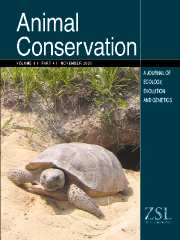Crossref Citations
This article has been cited by the following publications. This list is generated based on data provided by
Crossref.
RIVERS, NICOLA M.
BUTLIN, ROGER K.
and
ALTRINGHAM, JOHN D.
2005.
Genetic population structure of Natterer's bats explained by mating at swarming sites and philopatry.
Molecular Ecology,
Vol. 14,
Issue. 14,
p.
4299.
Pugh, Miriam
and
Altringham, John D.
2005.
The effect of gates on cave entry by swarming bats.
Acta Chiropterologica,
Vol. 7,
Issue. 2,
p.
293.
Davidson-Watts, Ian
Walls, Sean
and
Jones, Gareth
2006.
Differential habitat selection by Pipistrellus pipistrellus and Pipistrellus pygmaeus identifies distinct conservation needs for cryptic species of echolocating bats.
Biological Conservation,
Vol. 133,
Issue. 1,
p.
118.
Rivers, Nicola M.
Butlin, Roger K.
and
Altringham, John D.
2006.
Autumn swarming behaviour of Natterer’s bats in the UK: Population size, catchment area and dispersal.
Biological Conservation,
Vol. 127,
Issue. 2,
p.
215.
Furmankiewicz, Joanna
and
Altringham, John
2007.
Genetic structure in a swarming brown long-eared bat (Plecotus auritus) population: evidence for mating at swarming sites.
Conservation Genetics,
Vol. 8,
Issue. 4,
p.
913.
Glover, Anita M.
and
Altringham, John D.
2008.
Cave selection and use by swarming bat species.
Biological Conservation,
Vol. 141,
Issue. 6,
p.
1493.
Furmankiewicz, J.
2008.
Population size, catchment area, and sex-influenced differences in autumn and spring swarming of the brown long-eared bat (Plecotus auritus).
Canadian Journal of Zoology,
Vol. 86,
Issue. 3,
p.
207.
Vonhof, Maarten J.
Strobeck, Curtis
and
Fenton, M. Brock
2008.
Genetic Variation and Population Structure in Big Brown Bats (Eptesicus fuscus): Is Female Dispersal Important?.
Journal of Mammalogy,
Vol. 89,
Issue. 6,
p.
1411.
NGAMPRASERTWONG, THONGCHAI
MACKIE, IAIN J.
RACEY, PAUL A.
and
PIERTNEY, STUART B.
2008.
Spatial distribution of mitochondrial and microsatellite DNA variation in Daubenton's bat within Scotland.
Molecular Ecology,
Vol. 17,
Issue. 14,
p.
3243.
Lesiński, Grzegorz
2008.
Linear Landscape Elements and Bat Casualties on Roads — An Example.
Annales Zoologici Fennici,
Vol. 45,
Issue. 4,
p.
277.
Dzal, Yvonne
Hooton, Lauren A.
Clare, Elizabeth L.
and
Fenton, M. Brock
2009.
Bat Activity and Genetic Diversity at Long Point, Ontario, an Important Bird Stopover Site.
Acta Chiropterologica,
Vol. 11,
Issue. 2,
p.
307.
Durrant, Christopher J.
Beebee, Trevor J. C.
Greenaway, Frank
and
Hill, David A.
2009.
Evidence of recent population bottlenecks and inbreeding in British populations of Bechstein’s bat, Myotis bechsteinii.
Conservation Genetics,
Vol. 10,
Issue. 2,
p.
489.
Atterby, Helen
Aegerter, James N.
Smith, Graham C.
Conyers, Christine M.
Allnutt, Theodore R.
Ruedi, Manuel
and
MacNicoll, Alan D.
2010.
Population genetic structure of the Daubenton’s bat (Myotis daubentonii) in western Europe and the associated occurrence of rabies.
European Journal of Wildlife Research,
Vol. 56,
Issue. 1,
p.
67.
Puechmaille, Sébastien J.
Wibbelt, Gudrun
Korn, Vanessa
Fuller, Hubert
Forget, Frédéric
Mühldorfer, Kristin
Kurth, Andreas
Bogdanowicz, Wieslaw
Borel, Christophe
Bosch, Thijs
Cherezy, Thomas
Drebet, Mikhail
Görföl, Tamás
Haarsma, Anne-Jifke
Herhaus, Frank
Hallart, Guénael
Hammer, Matthias
Jungmann, Christian
Le Bris, Yann
Lutsar, Lauri
Masing, Matti
Mulkens, Bart
Passior, Karsten
Starrach, Martin
Wojtaszewski, Andrzej
Zöphel, Ulrich
Teeling, Emma C.
and
Arlettaz, Raphaël
2011.
Pan-European Distribution of White-Nose Syndrome Fungus (Geomyces destructans) Not Associated with Mass Mortality.
PLoS ONE,
Vol. 6,
Issue. 4,
p.
e19167.
Boughey, Katherine L.
Lake, Iain R.
Haysom, Karen A.
and
Dolman, Paul M.
2011.
Effects of landscape-scale broadleaved woodland configuration and extent on roost location for six bat species across the UK.
Biological Conservation,
Vol. 144,
Issue. 9,
p.
2300.
SMITH, G. C.
AEGERTER, J. N.
ALLNUTT, T. R.
MacNICOLL, A. D.
LEARMOUNT, J.
HUTSON, A. M.
and
ATTERBY, H.
2011.
Bat population genetics andLyssaviruspresence in Great Britain.
Epidemiology and Infection,
Vol. 139,
Issue. 10,
p.
1463.
Britzke, E.R.
Loeb, S.C.
Romanek, C.S.
Hobson, K.A.
and
Vonhof, M.J.
2012.
Variation in catchment areas of Indiana bat (Myotis sodalis) hibernacula inferred from stable hydrogen (δ2H) isotope analysis.
Canadian Journal of Zoology,
Vol. 90,
Issue. 10,
p.
1243.
Bogdanowicz, Wiesław
Piksa, Krzysztof
and
Tereba, Anna
2012.
Genetic structure in three species of whiskered bats (genusMyotis) during swarming.
Journal of Mammalogy,
Vol. 93,
Issue. 3,
p.
799.
2012.
Fly-and-Forage Strategy in the Bat Pipistrellus nathusii During Autumn Migration.
Acta Chiropterologica,
Vol. 14,
Issue. 2,
p.
379.
Serangeli, MT
Cistrone, L
Ancillotto, L
Tomassini, A
and
Russo, D
2012.
The post-release fate of hand-reared orphaned bats: survival and habitat selection.
Animal Welfare,
Vol. 21,
Issue. 1,
p.
9.


